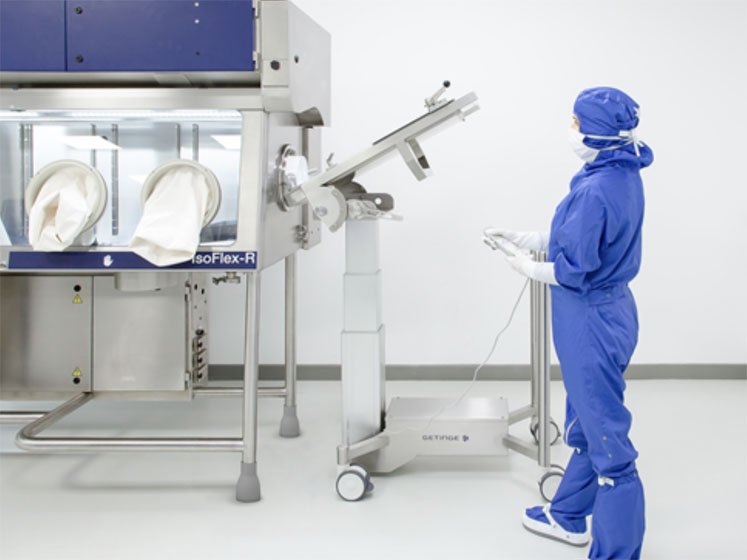Today’s pharmaceutical and biotech production sees technicians manually lifting, carrying and emptying sizable receptacles of sterile materials. Fragile components must be handled with care, sterility assurance and containment are imperative and we have to ensure that leak-tight transfer is maximised at all times.
But manual material handling (MMH), if not supported by stringent standard operating procedures (SOPs), may be prone to human error. There is also a growing occupational health issue with the repeated strain of limbs, shoulders and backs, making technicians susceptible to musculoskeletal injuries and chronic disorders that cause pain and even disability.
Optimising the journey to the production line
For more than 50 years, the DPTE system from Getinge has helped project leaders and process engineers to achieve high-speed filling line production without compromising the integrity of aseptic transfer.
The benefits of this system have now been extended with the introduction of an innovative, purpose-built mobile transfer platform — the DPTE Transfer Trolley — to alleviate the reliance on manual carrying and loading … and the associated risks and constraints.
The development of the DPTE Transfer Trolley has followed extensive engagement with customer challenges and a close collaboration with IMA Life during the design review process. “This has enabled a new ergonomic design approach that addresses the needs of the operator while maintaining system integrity,” commented Sergio Manera, R&D Department, IMA Life.
Shortcomings of incompatible transfer platforms
The need for a purpose-built solution has become explicitly clear. We found many instances of tables and rigs being used to support technicians by helping them to transport large containers to the docking port and then elevate and hold them during the loading process. Analysis done in co-ordination with the IMA Life team showed some profound limitations with these devices. For example
- different loading ports within the same production environment may vary in height, whereas the device’s level is typically fixed
- materials require different elevations to evacuate at a safe speed (liquids, bulk powders and solid components), but single devices cannot meet these requirements without additional manual tilting
- most devices assume the use of the same container, which is unable to accommodate all diameters and volumes and incompatible with both rigid, reusable canisters and single-use Polyethylene (or similar) bags
- the manual task of stabilising devices is often difficult and time-consuming, and can risk significant damage to isolator doors and walls
- large and/or heavy platforms occupy too much space and manoeuvring them is likely to cause as many MMH-related injury risks as they prevent.
Working with partners such as IMA Life, as well as numerous customers, Getinge has developed the DPTE Transfer Trolley, a smart transfer platform for use with all standard DPTE Beta solutions.

A DPTE-BetaBag tilted for unloading
Prioritising safety for people, processes and products
The DPTE Transfer Trolley is electrically assisted with enhanced ergonomics for ease of handling. Using it is almost effortless and, because it’s an integral part of the total DPTE solution, sterility or containment are never compromised.
In fact, the flexibility of the DPTE Transfer Trolley extends the value of all DPTE Alpha port environments through its cross-compatibility with DPTE-BetaBag and DPTE Beta Container solutions.
It has a broad elevation range of up to 1800 mm and can carry, rotate and incline (up to 90°) loads of up to 50 kg to facilitate optimum aseptic transfer via any DPTE system.
Its native compatibility with DPTE-BetaBag and DPTE Beta Containers enables two format solutions from the same frame. All available diameters and volumes of each format can be supported with minor reconfiguration, the sole exception being the 460 mm DPTE Beta Container.
The DPTE Transfer Trolley has a number of smart controls governing its safe and efficient handling.
Minimal training is required to take advantage of its full manoeuvrability, including all-wheel braking, precision motors for fine-tuned positioning and multidirectional castors for maximum mobility.
In the opinion of Sergio Manera and his R&D colleagues at IMA Life in Ozzano dell’Emilia, Italy, perhaps its most “game-changing” function is the ability to set and restore pinpoint alignments via its programmable memory. “We found this enables precision centring at speed, supporting the safe and efficient docking of DPTE-BetaBag and DPTE Beta Container formats to the DPTE Alpha port,” he said.
All of these features are delivered in a compact, space-saving 1000 x 700 mm footprint that makes the DPTE Transfer Trolley suitable for smooth operation within any cleanroom environment. Its pharma-grade finish and long-life rechargeable lithium batteries are also compliant with all relevant safety standards.
Time for a smart solution
The DPTE Transfer Trolley extends the proven DPTE system for aseptic transfer and addresses a missing link in the production process.
As pharmaceutical and biotech companies continuously face increasing demands on production, which inevitably drive the need for more units to be transferred at greater frequency, production managers can harness the DPTE Transfer Trolley to mitigate the risks of manual material handling, safeguard their employees and focus on a safer, more efficient future.
